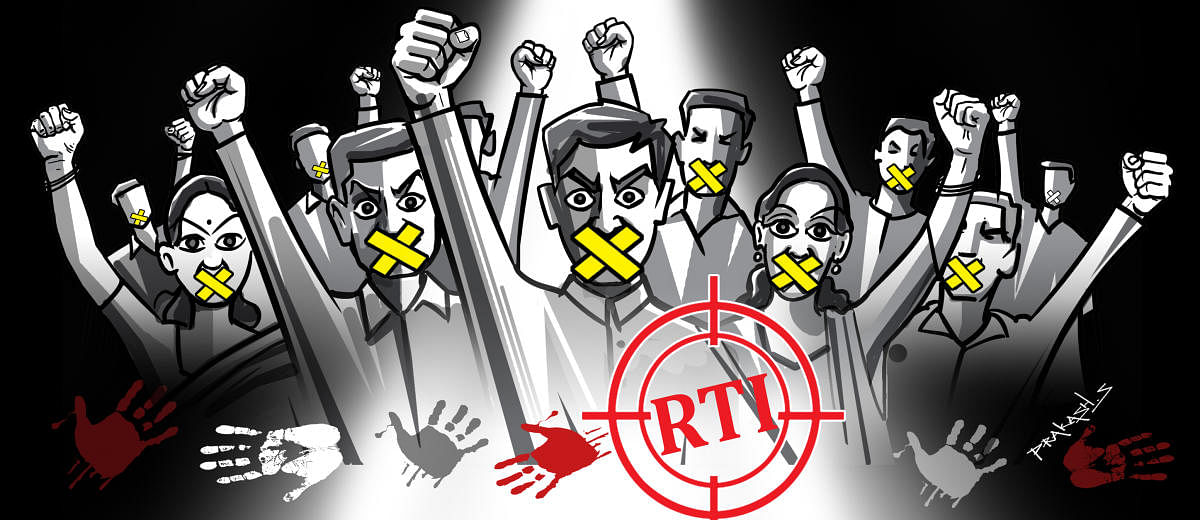
One fine morning seven years ago, Jeetendra Ghadge woke up to a ‘handwritten, illegible’ notice from a tahsildar to prove that he is the real owner of a 6.5-acre plot in a nondescript village in Maharashtra’s Satara district that he inherited from his late father.
Ghadge, now 37, did prove that he is the owner but only after he and his mother shuttled several times between their home in Mumbai, around 290 km away from the village Ransingwadi where he owned the land. Ghadge believes it was no coincidence that such a notice came within four months of his RTI on long-pending dam projects in Maharashtra, which was reeling under drought, created a storm in the state.
A couple of years later, Ghadge was again in trouble with police slapping an extortion case against him after he crossed paths with a Mumbai builder. He had gone to the builder with municipal officials but things turned ugly with him being confined to a locked room. Ghadge called police but he claims the victim became the accused in the police station, as ‘revengeful’ officials used it as an opportunity to fix him.
Ghadge, whose RTIs exposed surging farmer suicides and corruption in government and embarrassed successive Congress and BJP governments in Maharashtra, continues to face trouble while filing RTIs and claims his complaints to Anti Corruption Bureau are not investigated properly.
He does not face physical harassment or a threat to life like many who use the RTI route. He says he is lucky because he is a known figure and media is aware of his work.
“I am safe. Many RTI activists in the metros will not face any case, they are treated well because of their connections. But if you are a villager filing an RTI on Mahatma Gandhi National Rural Employment Guarantee Act or ration, then the contractor may be unhappy, the sarpanch may be unhappy. These are the people who are attacked, harassed, threatened or killed,” Ghadge tells DH.
There is no official statistics or study to buttress this point but activists point out that a cursory look at incidents show that there is an overwhelming number of attacks on socially and economically vulnerable people, especially from rural areas, who used RTI. Information seekers act individually and this adds more to their vulnerability. They face the consequences when they try to upset the status quo diligently nurtured by a nexus of the powerful.
Don’t you dare
Caste and economic status do play a role, activists feel, as ‘vested interests’ feel threatened by the use of RTI, which is empowering citizens to question the authorities, by those on the margins of the social ladder. Activists, who interacted with common people who used RTI, say they had come across complaints that RTI users were dissuaded by authorities when they seek information by reminding them of ‘consequences’ like those in power harassing them.
There were even cases of social ostracisation of RTI users with the community itself siding with the authorities. Seventeen women and their families in Meghalaya faced ostracisation after they filed RTI in 2011 following not receiving food grains meant for BPL families for at least 72 months prior to that.
Toddy tapper Raju Goud’s family was ostracised in Telangana after he sought information about suspected irregularities in electric transformers installed in his village. Three students, including one who was visually challenged, also faced the same punishment in Telangana for taking on a tahsildar.
Take the case of Nargis T Sangma in Meghalaya’s South West Garo Hills. She landed in hospital this April after she was assaulted by the family of a village employment council secretary for seeking details of using government funds by the official to allegedly construct a boundary wall around his house. Nilbath Ch Marak from the same state was threatened by a municipality’s Public Information Officer, who is mandated to deal with the RTI. He was asked if he was aware of the attacks on those seeking information.
In northern Kerala’s Kanhangad, one T V Narayanan was beaten up last November after he sought information as to why six well-to-do families with houses, cars and members working in the Gulf were granted BPL ration cards. If these incidents spoke about assaults or threats, the case of Bhola Sah of Bihar was more dire as he lost his life in December 2018, a day after he was kidnapped on the pretext of taking him to the police station for filing RTIs on several welfare schemes. He was the fifth to lose life in Bihar last year alone.
There are no consolidated official data but one compiled by Commonwealth Human Rights Initiative (CHRI) using media reports shows at least 83 people were killed, 170 assaulted, 185 harassed or threatened while seven committed suicide since the Right to Information Act was enacted in 2005. Maharashtra with at least 99 incidents, including 17 murders, and Gujarat 45 incidents, including 11 murders, lead the list of ignominy. Karnataka has 36 incidents, including 8 murders.
Records not available
Transparency International India’s ‘2019: State Transparency Report: Journey So Far and Challenges Ahead’ depicts a poor picture on the understanding of governments and Information Commissions on the harassment faced by RTI users. Many State Information Commissions (SICs) either do not maintain records or collect data about threats and harassment over the years. However, Uttarakhand SIC says it has recorded 405 cases since 2008 while Odisha has eight since 2008. Arunachal Pradesh and Manipur have one case each recorded. Either cases are not recorded in other states or data is not available.
“The biggest challenge in the upcoming years is to ensure the protection of information seekers as cases of harassments and murder of RTI applicants is increasing across the country,” the report released on October 11 said.
Activists vouch that the numbers are just a tip of the iceberg. “A large number of threats or assaults are not reported. Murders get highlighted through media. But many cases in which there is a clear case of use of RTI, police do not highlight this aspect. Investigators very often try to pass murders of RTI activists as cases of personal enmity or property dispute,” says Anjali Bhardwaj of National Campaign for Peoples’ Right to Information (NCPRI).
Security not given
Police too are not helpful or side with the oppressor despite receiving complaints of repeated threats. Take the case of Valmiki Yadav, who hailed from Bihar’s Jamui and was murdered in July 2018. He had filed several RTIs and was shot dead following his complaint on the appointment of an anganwadi worker.
Yadav’s father was threatened that his son will be killed and the victim had even written to authorities about it but no security was provided to him. A fact-finding report of NCPRI and National Alliance of People’s Movement (NAPM) claims that it is not even known whether the officer concerned had even read his letter. “If their security was managed in time, they would not have been killed,” it says.
A senior central government official said the attacks on RTI users are “unfortunate” and state and police should be pro-active in providing security when complaints reach them. “The numbers are not high compared to the RTI applications. But that is not a consolation. Officers need to be more sensitive to such complaints,” the official said.
What is the way out? CHRI’s Venkatesh Nayak says government should proactively disclose information sought on issues of public interest.
Bhardwaj says researches show that nearly 70% of RTIs are such that they are seeking information that should have been in any case could have been provided pro-actively by the governments as prescribed in Section 4 of Right to Information Act, 2005.
“If authorities are not forthcoming, people have no choice but to file RTIs. Someone gets attacked or killed is because someone wants to withhold information. When there is a threat or an attack, it is very important that the Information Commissions take action. That will act as a huge deterrent,” she says.
There is also a clamour for implementing the Whistleblowers Protection Act. They also demand that RTI activists need to be identified as human rights defenders. People also demand a more proactive approach by the National Human Rights Commission by ensuring its intervention when the RTI link to an attack or murder is downplayed.
